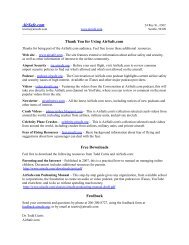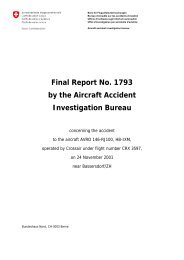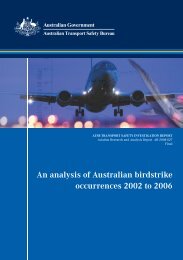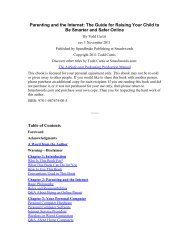AAIB Investigation Updates (PDF) - Airline Safety and Security ...
AAIB Investigation Updates (PDF) - Airline Safety and Security ...
AAIB Investigation Updates (PDF) - Airline Safety and Security ...
You also want an ePaper? Increase the reach of your titles
YUMPU automatically turns print PDFs into web optimized ePapers that Google loves.
<strong>AAIB</strong> Interim Report 2 G-YMMM EW/C2008/01/01<br />
The tests that have been carried out were all related<br />
to the Boeing 777 <strong>and</strong> Trent 800 fuel system. It is<br />
unknown if other airframe‐engine combinations<br />
are susceptible to this phenomenon; therefore<br />
Recommendation 2008‐048 was made to EASA <strong>and</strong><br />
the FAA in the initial interim report to address this<br />
concern.<br />
Anti‐ice additives in aviation fuel<br />
Ice in aviation turbine fuel is an industry‐wide problem<br />
<strong>and</strong> currently the mechanism by which it accumulates<br />
<strong>and</strong> is released within an aircraft <strong>and</strong> engine fuel<br />
system is not fully understood.<br />
The military, <strong>and</strong> some business jet operators, have<br />
used anti‐icing additives in aviation turbine fuel as<br />
a means of preventing ice from forming within the<br />
aircraft <strong>and</strong> engine fuel systems. The widespread<br />
use of such additives would reduce the risk from ice<br />
in fuel. However, its introduction worldwide would<br />
not only require changes to the infrastructure <strong>and</strong><br />
ground fuel h<strong>and</strong>ling systems, but it could also lead<br />
to increased aircraft maintenance. Moreover, unlike<br />
the Boeing 777, not all aircraft are currently cleared<br />
to use existing anti‐icing additives.<br />
Despite the difficulties, the use of an anti‐icing additive<br />
could significantly reduce, or even eliminate, ice<br />
formation in aviation turbine fuel. Therefore, to clarify<br />
the current issues:<br />
<strong>Safety</strong> Recommendation 2009-030<br />
It is recommended that the Federal Aviation<br />
Administration <strong>and</strong> the European Aviation <strong>Safety</strong><br />
Agency conduct a study into the feasibility of exp<strong>and</strong>ing<br />
the use of anti‐ice additives in aviation turbine fuel on<br />
civil aircraft.<br />
© Crown copyright 2009<br />
Future industry activity<br />
The formation of ice in aircraft fuel systems from<br />
dissolved <strong>and</strong> entrained water in aviation turbine<br />
fuel is well documented <strong>and</strong> is largely based on<br />
observations <strong>and</strong> conclusions made during research<br />
projects undertaken in the 1950s. This research formed<br />
the basis of the SAE Aerospace Information Report<br />
(AIR) 790 <strong>and</strong> SAE Aerospace Recommended Practice<br />
(ARP) 1401, which advises the aerospace industry on<br />
suggested procedures to test aircraft fuel systems <strong>and</strong><br />
components for icing.<br />
This early research established that it is possible for ice<br />
to form from dissolved water, alone, in aviation turbine<br />
fuel which can then block filters <strong>and</strong> small orifices. A<br />
number of different types of ice were observed which<br />
was described as being ‘slush ice’ <strong>and</strong> ‘soft white ice’,<br />
which when melted contained between 10% <strong>and</strong> 30%<br />
water. During this period the United States Air Force<br />
(USAF) undertook research into the formation of ice<br />
in fuel <strong>and</strong> observed that not all the water droplets<br />
form ice crystals, but some of the water remains as<br />
supercooled droplets. The research concluded that<br />
the type of ice is dependent on a number of factors<br />
including the rate of cooling, water droplet size <strong>and</strong><br />
the agitation of the fuel. It was also noted that the<br />
variation in fuel composition between batches of fuel<br />
affects the concentration <strong>and</strong> size of the water droplets<br />
<strong>and</strong> the amount of subsequent icing.<br />
A solution to the early icing problems was to produce a<br />
remedy for the specific problem: fuel heaters <strong>and</strong> filter<br />
bypasses were introduced <strong>and</strong> the optimum mesh size<br />
for the boost pump inlet screens was determined. The<br />
USAF, like other military organisations, introduced<br />
Fuel System Icing Inhibitor (FSII), which can help to<br />
prevent the formation of ice.<br />
11











